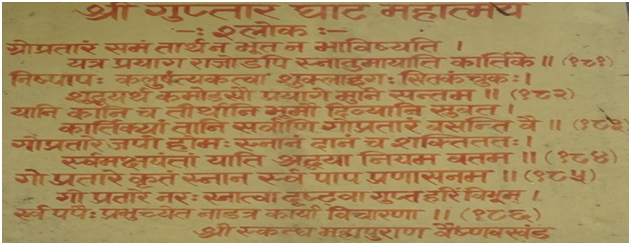Importance of Guptar Ghat can be ascertained by its mention in various religious scriptures. Find below the ‘shlokas’ in Skandh Purana describing the significance of this ghat:

There are some temples near Guptar Ghat like Narasingh Temple, Sita-Ram Temple, Raja Mandir, and Chakra Hari Vishnu temple. It is said that there are impressions of the feet of lord ram in Chakra Hari Vishnu Temple. Various nearby temples generate a feel of peace. Another attraction on Guptar Ghat is Kartikeya Seva Sadan, a spiritual center. It was the place where Saint Kartikeya of the Bhakti tradition resided only 50-60 years ago. One can enjoy a pleasant view of sunrise and sunset while feeling the breeze of fresh air on the bank of river. There one can enjoy boat ride too while viewing the surroundings of the river.
The most attractive aspect of the Gupta Ghat is its natural environment and extensive forest land here. There is Cantt - Dogra Regiment
Center – here. The forest or garden near the ghat was previously called Company Garden but, now, known as Guptar Ghat Van. One can enjoy
greenery and natural beauty. Different kind of flowers can be seen here. Faizabad Museum is near to the ghat. Other major attractions of
Ayodhya city (previously called Faizabad) are Gulab Bari, Bahu Begam Ka Maqbara (Tomb of Bahu Begum) and Fort Calcutta.
There is a Samadhi of Gumnami Baba which is assumed to be of Netaji Subhash Chandra Bose, India’s freedom fighter and founder of INA (Indian National Army).
In 19th century, Raja Darshan Singh has done efforts to renovate Guptar Ghat. Presently, UP government and Uttar Pradesh tourism department are doing their level best to increase facilities and conditions of the ghat. It takes almost one hour generally to enjoy the serene ambience of Guptar Ghat. One can sit there for hours to enjoy the morning or evening with some peace. Entry to the ghat is free.